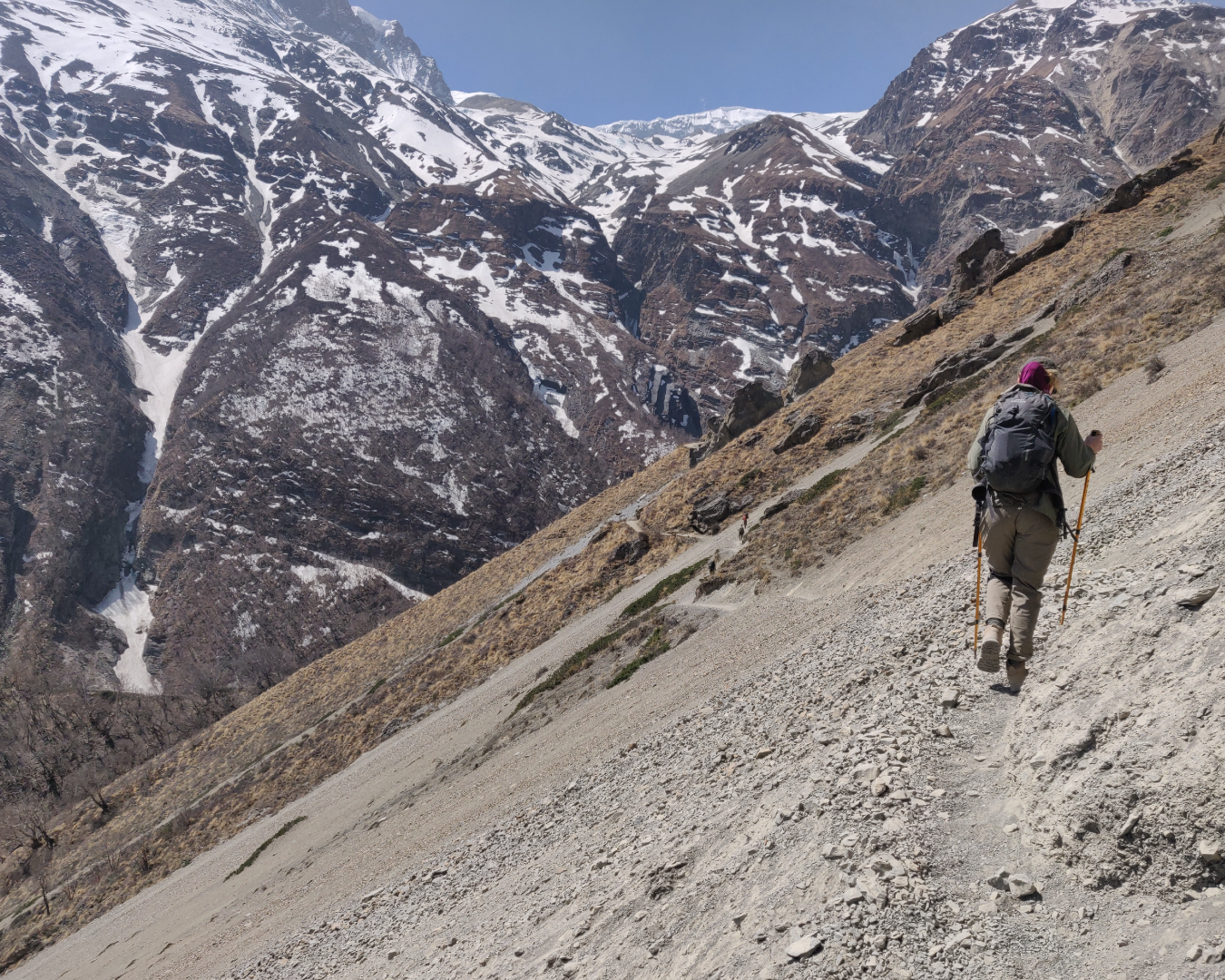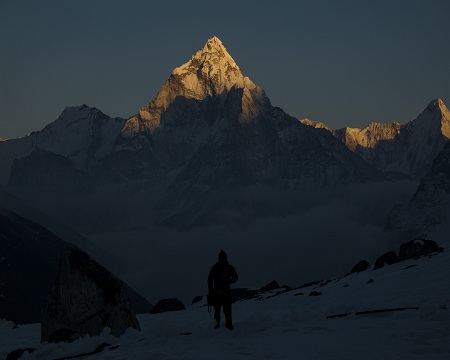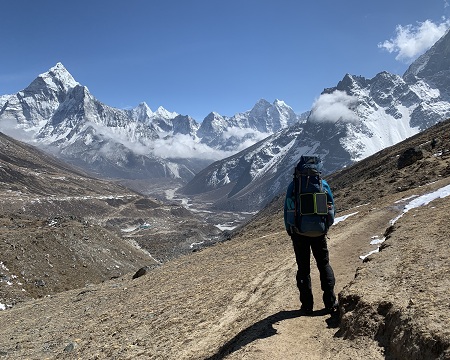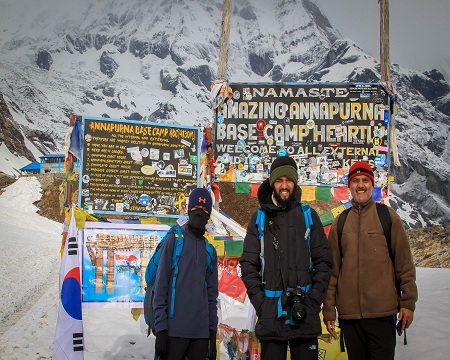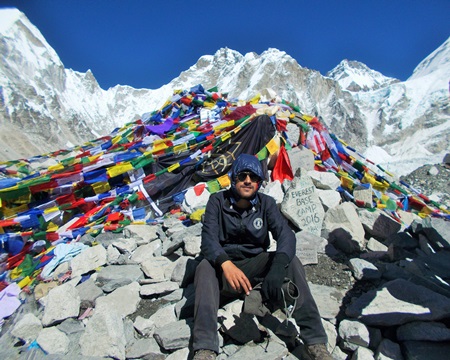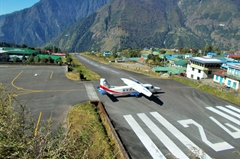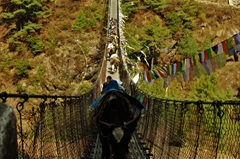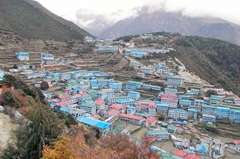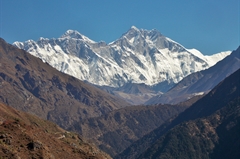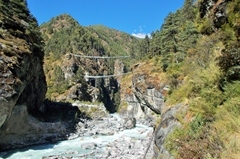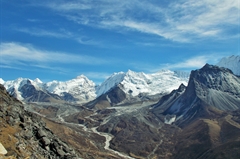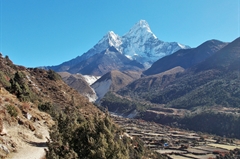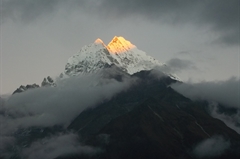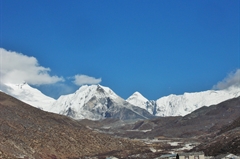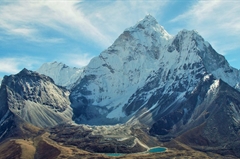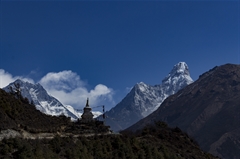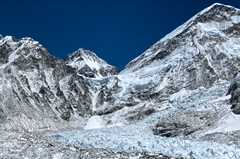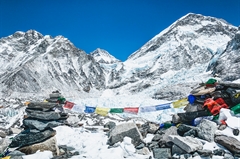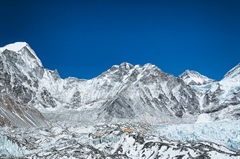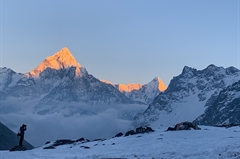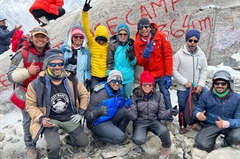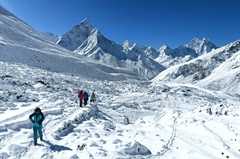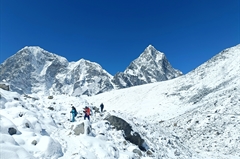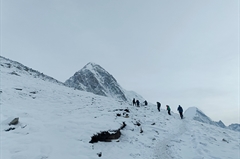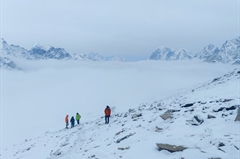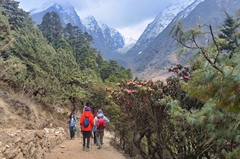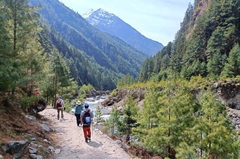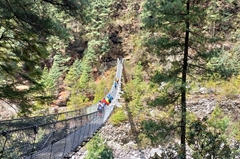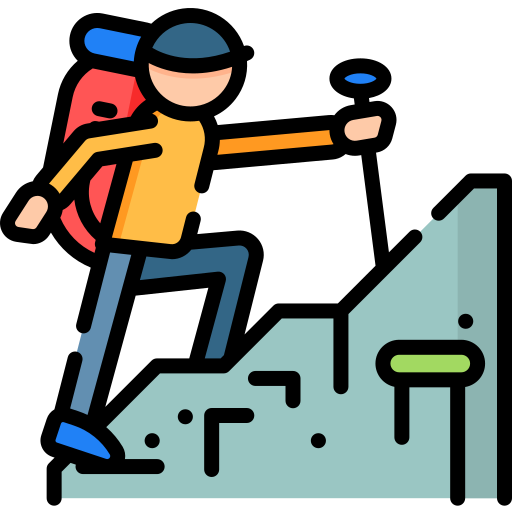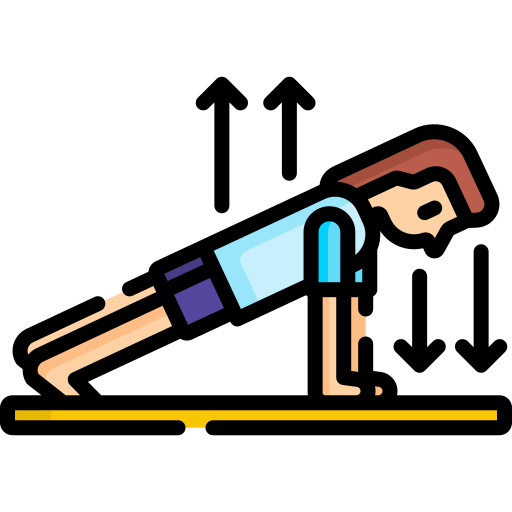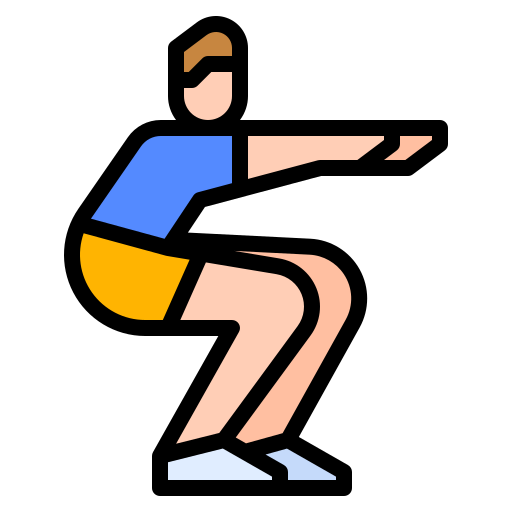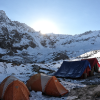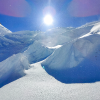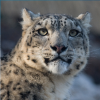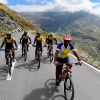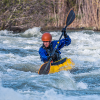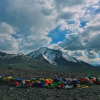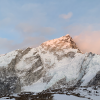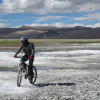Everest Base Camp Trek
Walk where the Legends walked.
Available Batches
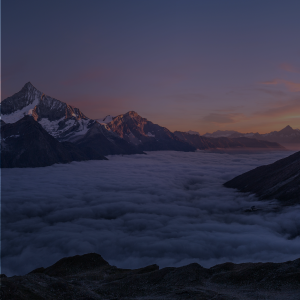

Brief Description
Brief Itinerary
Detailed Itinerary
Day 1
Arrive in Kathmandu (1,330M)
Day 1 is reserved to make your way to the bustling capital city of Kathmandu. Its colourful, crowded streets packed with shops stacking trekking and climbing gear to their very top in addition to the many tourist hotels and cafes with high mountains in the backdrop is enough to suggest that trekking in Nepal is going to be a different experience. With crowds from across the globe sifting through the city in search of climbing gear suited for the highest mountains, this place is your best bet if you need to buy some top-class equipment, at the best rates, for your future climbs or if you are missing something for the one you are on now! The shops and cafes in Kathmandu accept Indian currency but you might want to take this day to exchange your money to Nepal currency since cash is the only medium of payment on the higher reaches of the trek and the only money accepted in tea houses above is local currency.
Day 2
Kathmandu (1,330M) to Lukla (2,860M) to Phakding (2,652M)
Duration: 35 min (flight to Lukla) + 3 hour (trek to Phakding)
Distance: 7 km trek
Today is the first day of the trek but not before we take a short flight up to the trail head. After breakfast we proceed to Tribhuvan Domestic Airport, Kathmandu for our flight out to Lukla. The flight over mountains in the Khumbu Region is all of 35 minutes but presents you with some of the most exquisite views of Nepal and can easily be one of the highlights of this trek. If you get a seat on the left side of these tiny planes, the view out the window is one you’ll never forget. Lukla is a small village with no road, only reachable by flight or foot. We walk straight out of the airport, across the cobbled stone footpath of the village and off into the forest trail, officially starting our first day of trekking. Just before exiting the village, we are required to present the first of our two permits at the check post – so remember to keep these handy. Today is easy - it is a simple trek for 3 hours which starts with descending 300M and then slowly climbs up 100M to meet the rest point for the night - Phakding. Along the way, we pass countless mani walls painted on the rocks lining the trail and boulders carved with Tibetan Buddhist prayer inscriptions. We also find numerous prayer wheels all along the trail. We spend our first night in a tea house at Phakding.
Day 3
Phakding (2,652M) to Namche Bazaar (3,440M)
Duration: 6-7 hours
Distance: 11 km
Its serious business from today onwards – today marking day 1 of our brush with difficult terrain on this trek. We start by walking along the banks of the Dudh Kosi, crossing it twice on the high suspension bridges Nepal treks are famous for. The trail is a series of small, repeated ascents and descents, following along the river and again crossing the engraved Buddhist stones characteristic of the area. We stop for lunch at the village of Monjo, which is also the gateway to Sagarmatha National Park. Here is where we present the second of our two permits. After entering the park, we descend along an enormous wall painted sky-high with prayers written in Tibetan to the Bhote Kosi River arriving at Jorsalle village. This is where all the fun begins. After one final stroll along the beach-like riverbank, the trail gets steeper passing through dense forests. After a while we cross the last suspension bridge for today – the bridge dangling spectacularly high above a sharply-descending gorge. From here, we ascend 600M through a thickly forested patch all the way to Namche Bazaar, the administrative and trade capital of the Khumbu region. If the weather is clear we might get our first view of Everest at the rest point along the way. Overnight stay in tea house in Namche Bazaar.
Day 4
Namche (3,440M) to Tengboche (3,860M)
Duration: 6-7 hours
Distance: 10-11 km
Tengboche is a small valley at an altitude of 3,860M. This beautiful route between the two villages starts with us passing through Namche on a stone-paved path by the stream. Thamserku, a beautiful peak of 6,608M, dominates the view, with Ama Dablam – one of the most peculiarly shaped mountains – farther up the valley. Everest is visible above the joining ridge of the south face of Lhotse and Nuptse that close the valley far ahead. Close to an hour into the trek, we come across a huge chorten dedicated to Tenzin Norgay – the man who needs no introduction. The trail is small sections of ascents with patches of descents that are enough to recover your breath for the next section of ascent. We should reach our stop-hold for today by lunch-time.
Day 5
Tengboche (3,860M) to Dingboche (4,410M)
Duration: 5-6 hours
Today we start our trek early and head out of Tengboche over to the other side of the ridge and straight into a birch and rhododendron forest. From here, Lower Pangboche is close to 4 km – with a height gain of close to 260M, we should get there in less than 2 hours. The village of Pangboche is spread out right below the impressive Ama Dablam and hence offers some of the most spectacular views of the mountain making it a perfect spot to take a break. Depending on what time we get here, we either stop for tea or head straight for lunch. Everest now disappears from the view until we reach the upper parts of the Khumbu Valley. We see a lot of revered peaks all through our trek today, don’t forget to question your local guide about these each time you see a new peak peering out from behind at the turn of the view.
To our left is the Lobuche River. Dingboche comes into view after a series of moraines. This large settlement has some spectacular sights to offer with the south face of Lhotse (8,516M) dominating the view. Do not miss the sunset from this beautiful location.
Day 6
Acclimatization day at Dingboche (4,410M)
We have climbed over 2000M in the last few days. This marks for a good milestone to take a day off so as to rest the body and give it time to acclimatize to this newly gained elevation. This makes it easier for it to handle the elevation it has to face in the coming days. Acclimatization is done best and done right when you expose yourself to the mountain air at this elevation – so remember to take yourself out and walk around. There is much to see and admire in this region. A small hike from here brings you face to face with three of the world’s highest mountain peaks - Mount Lhotse, Mount Makalu and Mount Cho Oyu.
Day 7
Dingboche (4,410M) to Dughla/Thukla (4,620M)
Duration: 3 hours
Distance: 5 km
Today is the shortest of all days on the trek which seems easier still after resting it out at Dingboche yesterday. The flat trail till Dughla offers some of the best views on this route along with a spectacular view of the wall of Khumbu Glacier. On our right, we see the magnificent Mount Pumori (7,138m) and a brightly colored glacial lake. There are no tea houses between these two locations, and no sources of water either – remember to carry sufficient supplies of refreshment as well as water for today.
Day 8
Dhugla/Thukla (4,620M) to Lobuche (4,940M)
Duration: 3.5 hours
Today we start our trekking towards Lobuche which is situated beside the Khumbu glacier. Initial part of the trek is tough as we undertake the strenuous climb up to Dughla Pass/ Thukla Pass to go onwards to Lobuche. The climb is short but extremely steep – if it’s any consolation, it offers some of the most memorable views of the entire trek. The pass is filled with memorials of mountaineers who got the ball rolling for all of us to be here today. We spend some time at the pass before we carry on to Lobuche – the trail after the pass is mostly flat.
Day 9
Lobuche (4,940M) to Gorakshep (5,164M) to Everest Base Camp (5,364M) and back to Gorakshep (5,164M)
Duration: 7 – 8 hours
Today's trail has a lot of ups and downs till Gorakshep – most of these are humps on the moraines of the infamous Khumbu Glacier. Once we reach Gorakshep, we have something to eat and leave straight after to get to Everest Base Camp - situated at the beginning of the massive Khumbu Glacier. The trail walks along the glacier with extraordinary views of Mt. Pumori to our right and Mt. Nuptse to our left. We get a clear as day view of the Khumbu icefall from the base camp – a view that’s inspiring enough to up your trekking game. This portion of the trek also brings us face to face with some of the biggest mountains in Nepal and in the world – the feeling of being surrounded by giants is almost surreal. We need to hike on the Khumbu glacier for a short bit in order to get to Everest Base Camp – giving us a tiny feel for what it must be like to climb up this beast of a mountain. We spend some time at the base camp soaking in the views before we head back down to Gorakshep on the same trail.
Day 10
Gorakshep (5,164M) to Kala Patthar (5,644M) to Pheriche (4,371M)
Duration: 7 – 8 hours
Today is the most exciting day of the trek, if you ask us! With views to die for, it is everything we have been secretly waiting for throughout the trek. We start early to make our way to Kala Patthar – a place kind enough to give us the clearest views of Everest on this entire trail – it will however, take some effort. The trek to the summit of Kala Patthar is one of the most difficult but also highly rewarding. After the trek to Kala Patthar, it is easy to imagine why Everest is the most sought after mountain on the planet and why it’s captured the fancy of some of the most accomplished climbers across eras. In fact, Kala Patthar is the only place from where you can get views of almost the entire high peak mountains of the Khumbu Range – which is what makes it such an inspiring journey to make. It takes about 3 hours to reach Kala Patthar from Gorakshep. We can’t spend much time on the top as it’s an extremely windy place with nothing to obstruct the ferocious winds.
From Kala Patthar, it’s only descent all the way to Pheriche. This almost 1,300M of descent should take about 4 hours. Pheriche lies on a flat valley on the bank of Dhudhkoshi River.
Day 11
Pheriche (4,371M) to Namche Bazaar (3,440M)
Today’s trek is moderate but is made easy in the memory of the awe-inspiring landscape we witnessed yesterday. There are small patches of ascent before Tengboche and after Phungi Thanga.
Day 12
Namche Bazaar (3,440M) to Lukla (2,860M)
The last day of our trek in the gorgeous Khumbu region, it is one which must be savored. Walking on this familiar trail gives you the opportunity to better enjoy its beauty without having to worry about familiarizing yourself to it like we did the first time around. With no rush to get anywhere, this is literally a walk in the park.
Day 13
Lukla (2,860M) to Kathmandu (1,330M)
Airborne, we once again witness the beauty of Nepal from a bird’s eye view which is the perfect way to end this breathtaking journey, if you ask us!
Day 14
Departure
It is time to bid adieu to the Everest Base Camp Trek here. The check-out time is 12 noon. Please note that we can arrange for a drop-off at the airport on request.
What's Included
- Domestic airport transfers for Lukla flights.
- Accommodation in Kathmandu (2 nights)
- Accommodation during the trekking period (11 nights).
- Domestic return flights (Kathmandu/Ramechhap- Lukla -Kathmandu /Ramechhap).
- All necessary paperwork and trekking permits (National Park Permit, TIMS)
- Mountaineering course certified Bikat's Trek Leader for group size of 6 & above only.
- Staff costs including their salary, insurance, equipment, domestic airfare, food and accommodation
- Medical kit (carried by your trek leader).
- All government and local taxes.
- Please Note: For single trekker we provide porter cum guide.
- Experienced and Certified guide
- Kathmandu Airport pickup & drop to hotel on Day 1 & 14 only.
- Three meals (Breakfast, Lunch & Dinner) a day during the trekking (open menu to choose one item per meal from the menu). Order more at your own cost.
- Backpack Offloading upto 10 Kg per participant
What's Not Included
- Soft-drinks / Beverages / Alcohols / Snacks / Chocolates Etc
- Additional accommodation and food expenses if trek gets delayed due to weather, flight cancellation, health or any other reason
- Personal expenses (phone calls, laundry, bar bills, battery recharge, extra porters, bottle or boiled water, shower, etc.).
- Health Insurance, Personal Insurance and other travel insurance
- Expenses for evacuation and rescue operations due to natural calamity, mishaps, injury or any health problem.
- Nepalese visa fee.
- Tips for guide(s), porter(s).
- Gaiters, microspikes and sleeping bags (wherever necessary) are not included and thus have to rented from Kathmandu by you.
Are you Eligible for this Adventure?
Everest Base Camp Trek is 120 kilometers of sheer awe, divided into approximately 8-10 kms per day. It takes you to an elevation of 5,545M. Given the duration of the trek and the altitude it continually keeps you in, sound fitness and some experience in the Himalayas is essential before you decide to go on this journey of a lifetime.
BRS Level Required
This makes it mandatory for you to have high-altitude experience of preferably multiple treks marked at level 4 on the BRS. The altitude, the terrain and the nature of the climb demand a certain level of skill and a need for you to be aware of how your body reacts to the various features of a high altitude environment.
If you do not know what level of BRS trek would suit you best, worry not! Fill out this Form:
we will send you a progression chart to help you comfortably get out of your comfort zone in order to level up and ultimately reach your highest potential in the big, bad world of outdoor adventure.
Packing List
This is a list of essential items for individuals doing the trek with Bikat Adventures. This list contains only those items which the participants are required to bring with them. The list excludes those items which are provided by Bikat Adventures on the trek. We have divided the items into five categories. All the items in the list are essential except for those marked as optional.
Trekking Gear
- Ruck sack bag with rain cover. Qty -1
- Day Pack Bag - Recommended for treks with summit day
- Head Torch with spare Batteries. Qty -1
- U V protection sunglasses. Qty -1 Here is how you can choose the best sunglasses for trekking.
- Water Bottles: 2 bottles of 1 liter each
Footwear
- Non-skid, deep treaded, high-ankle trekking shoes Qty -1
- Pair of light weight Slipper/Sandals Qty -1
Clothing
- Quick Dry Warm lower or Track Pants. Qty - 2
- Full sleeves T-shirts/ Sweatshirts. 1 for every 2 days of trekking
- Pair of thick woolen socks. 1 pair for every two days of trekking
- Thermal Body warmer Upper & Lower. Qty-1
- Undergarments. Qty - 1 for every day of trekking
- Warm jacket closed at wrist & neck .Qty-1
- Full sleeves sweater. Qty -1
- Rain wear ( Jacket & Pants ) . Qty-1
- Pair of waterproof, warm gloves. Qty-1
- Woolen cap. Qty-1
- Sun shielding Hat. Qty -1
Toiletries
- Personal toiletries kit (Small Towel, Toilet paper, paper soap, Bar soap, toothbrush, toothpaste, cold cream, etc.)
- Sun screen lotion small pack. Qty -1 Here is your Sun Protection 101 to stay safe in the bright sunny outdoors.
- Lip Balm small pack. Qty-1
Utensils
- Small size, Light weight & Leak proof lunch box. Qty-1
- Plate. Qty- 1
- Spoon.Qty-1
- Tea/Coffee (plastic) Mug.Qty-1
Miscellaneous
- Camera (Optional)
- Carry your medicines in plenty in case you have any specific ailment. Consult your doctor before joining the trek.
- Dry fruits, Nuts, Chocolate bars (Optional)
Frequently Asked Questions
Why Bikat?
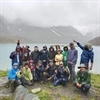

Small Group Size
Our batch sizes are capped at 15 for smaller treks with the trek leader and trekker ratio of 1:8. This ratio, in our years of experience, has proven to deliver the best trekking experience for individuals as well as groups. Capping the size of the group ensures individual attention to each trekker so that no signs of distress or need during the trek go unnoticed. It also helps to form a more cohesive cohort with better group energy which helps define the rhythm and pace of days on the trek. As you go higher up on the BRS scale, since the stakes are higher, expeditions have an even smaller group size with the ratio of expedition leader to climber set at 1:2.
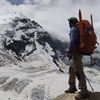

Qualified Trek Leaders
We follow a rigorous regime of hiring and training our experts in the field. Each trek leader is a certified mountaineer with years of experience in the field. In addition to their qualification, they also go through practical and situational training to tackle any and all kinds of sudden conditions that may present themselves on the ground. Being unpredictable is the core nature of the mountains but being ready for any circumstance as best as possible is a controllable asset that we try to nurture. Our field experts are also trained in basic medicine and first-aid response. Watch: Forerunners - The Making of A Trek Leader At Bikat Adventures
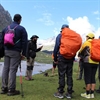

Guided Progression
Since Bikat Adventures is a learning-based organization, we help you climb up the ladder of difficulty within the sphere of outdoor adventure systematically. Our on-ground training modules are designed to handhold you through the upskilling process so that you are ready to take on bigger challenges.
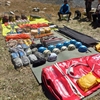

Equipment Quality and Check
All the gear used on our treks and expeditions is tried and tested, maintained for good quality, and is overall top-notch in quality and condition. We are continually looking to obtain the best of everything there is in the market so as to ensure optimum safety.
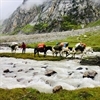

Support Systems
Along with the staff you see on-ground, we have a team of superheroes working in the background to give you the best experience possible. Our background team also comprises local staff from each area who know the region best. Having local support helps with studying the area, pre-planning, execution, and in receiving timely support in case of emergencies in these remote locations.
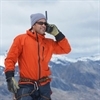

Communication
Our on-field staff is in constant contact with our teams based in primary locations so as to eliminate any avoidable delay in reaching additional help and support when required. We try to use the best tools for communication available, including satellite phones, in regions where they are not restricted.
What our customers Say
Cancellation Policy
Cash refund
Cancellations up to 60 days prior to departure date
Between 60 days upto 30 days prior to departure date
Between 30 days upto 10 days prior to departure date
Less than 10 days prior to departure date
Voucher refund
Cancellations up to 30 days prior to departure date
Between 30 days upto 15 days prior to departure date
Between 15 days upto 10 days prior to departure date
Less 10 days prior to departure date
- Cash refund is applicable only in case of bookings made without using any promotional offer code or Cancellation Vouchers or Discounts
- This is only a brief of cancellation terms. For finer details please refer Detailed Cancellation Policy.
Blog Posts
